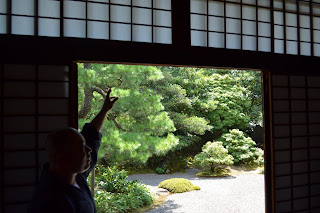The city of Kyoto is known as the epicenter of traditional Japanese culture, with more than 1600 Buddhist temples and over 400 colorful Shinto shrines. Kyoto, possibly more than anywhere else in Japan, has mastered the fusion of modernity and tradition, encouraging traditional dress while still maintaining an active business sector, high-rise buildings, and abundant western-style shops.
My visit began early in the morning, after the arrival of my overnight bus from Tokyo. My first stop was the Shunko-in Zen Buddhist temple. Built in 1590, the relatively new temple exemplified much of what has drawn me to eastern art over the years. The visual appeal of the dark wood details, contrasting white walls, luminescent shoji screens and verdant Zen gardens created an immediate sense of peace common in classic Zen architecture, while the gilded sliding door paintings by a Kano School artist depicted the social hierarchy, leisure activities, and intellectual elitism of the Japanese shogun and samurai.
My favorite part of my visit to Shunko-in was participating in a Zen meditation led by the vice-abbot of the temple. While I have meditated many times and was familiar with Zen practice, the monk’s simple explanations of routine forms brought new meaning to each custom. The meditation ended with a traditional tea ceremony which I enjoyed with my Japanese friends.
While I would love to spend more time in Kyoto, my day-long visit necessitated the selection of only a few key sights to see. I made my way over to Nijo castle next, the home of the Tokugawa Shogunate from 1626–1639. The palace is exemplary both for its ornate architectural details as and its well-maintained gardens where modern Japanese women sheltered under umbrellas recreate the feeling of Tokugawa geisha.
The apex of my stay in Kyoto was a late evening visit to Ninna-ji, a Shingon Buddhist temple founded in 888. My visit coincided with the Obon Festival, a three day celebration of the departed. As the sun set over Kyoto, huge crowds gathered at the base of the hill upon which the temple rests, all prepared with small messages and wishes to leave for their ancestors. At about 8:30pm, lights illuminated the temple structures and surrounding forest, and the visitors were allowed in to pay homage to the departed.
I have never seen a sight as breathtaking as the view from the highest structures of the Kiyomizu-dera complex just after sunset. The temple rests about halfway up a large hill, nestled delicately throughout the woods with an extraordinary view of downtown Kyoto. With every turn, visitors are greeted with an awe-inspiring vista set within an environment that encourages introspection and quiet meditation. I participated in as much of the festival as I could understand, drinking water from a wishing well and giving thanks for those who have gone before me.
My time in Kyoto was rounded out by an overnight stay in Ninna-ji, a Shingon Buddhist temple founded in 888. If you ever have the chance to visit Japan, I highly recommend staying in a temple. At Ninna-ji, I had my first Japanese bath experience (Japanese typically favor public baths over western showers), slept on a comfortable tatami mat on the floor of a large shared room, and awoke at dawn to witness the chanting of the Shingon monks in the main temple building. If I could begin everyday in such a meditative way, I have no doubt inner peace would follow throughout my day.
Up next, I will post about my experience visiting Hiroshima on the anniversary of the signing of the peace agreement between the US and Japan.










No comments:
Post a Comment